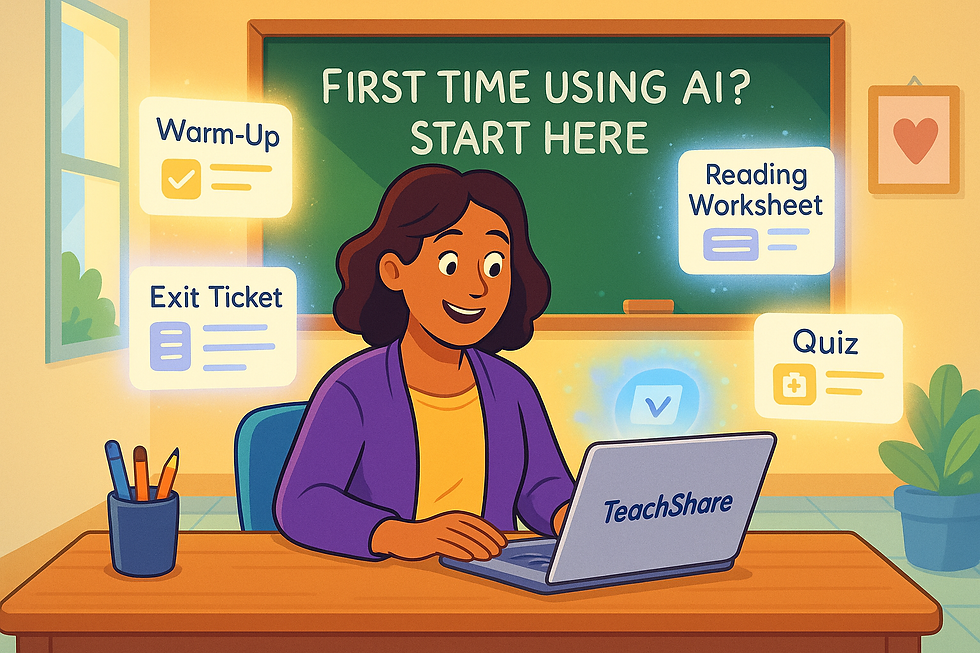How to Use AI to Apply Bloom’s Taxonomy to ESL Teaching (Using TeachShare and Chat-Bots)
- Tara Ellison
- May 15
- 4 min read

As ESL teachers, we’re always on the lookout for new ways to help our learners grow, not just in vocabulary and grammar, but in how they think, communicate, and express themselves in English.
One of the best tools we have to guide this kind of deep learning for our ESL students is Bloom’s Taxonomy. Now, with the power of AI and platforms like TeachShare, applying Bloom’s Taxonomy to your ESL materials has never been easier. In this post, we’ll walk you through what Bloom’s Taxonomy is, how to use it in your ESL classroom, and how to utilize AI to create more effective lessons in less time.
What Is Bloom’s Taxonomy?
If you haven't heard of Bloom's Taxonomy before, essentially it is a framework that helps educators design learning objectives that range from basic to advanced thinking skills. It’s often presented as a pyramid with six levels, moving from lower-order to higher-order thinking:
Remembering
Recalling facts and basic concepts (e.g., vocabulary, grammar rules)
Understanding
Explaining ideas or concepts (e.g., paraphrasing, summarizing)
Applying
Using information in new situations (e.g., role-plays, sentence construction)
Analyzing
Breaking information into parts and examining relationships (e.g., comparing texts)
Evaluating
Justifying a decision or opinion (e.g., expressing preferences, debating)
Creating
Producing new or original work (e.g., writing stories, designing presentations)
Using Bloom’s Taxonomy in your ESL class means designing activities that help students move beyond memorization and towards critical thinking in English.

How Can You Apply Bloom’s Taxonomy to Your ESL Class?
So, how can you apply this method to your classroom? Don't worry, you don’t have to redesign your whole curriculum! It’s all about tweaking your existing materials and goals so that students are practicing this new range of thinking skills in English. Here’s how that might look:
Remembering: Flashcard drills, fill-in-the-blank grammar sheets
Understanding: Illustrated vocabulary use, summarizing videos or readings
Applying: Writing a dialogue using new vocabulary, practicing a grammar point in context
Analyzing: Comparing two texts or characters, identifying cause and effect
Evaluating: Debating which travel destination is better and why, reviewing a movie
Creating: Writing a short story, making a class podcast, designing a travel brochure
The challenge? Coming up with tasks at every level can take up way too much time. That’s where AI is your best friend!
How to Use AI to Apply Bloom’s Taxonomy to Your ESL Materials
Now that we have AI, AI can do the busy-work while you focus on teaching and your students.
With TeachShare, you can create, share, and discover ESL teaching materials. You can generate teaching materials tailored to Bloom’s levels or modify existing worksheets to include Bloom's levels of thinking
All you have to do is:
Open TeachShare Creator and click "Create any Resource

Customize your resource for the specific topic you are teaching, and include specifications such as Grade, Standards, Lesson Phase, Source, and Boosts. Then click the arrow button and allow TeachShare to generate your resource!

Once your resource is generated, simply use TeachShare Chat to refine it by asking: "Can you adjust this worksheet to include questions and activities aligned with Bloom's Taxonomy, covering remembering, understanding, applying, analyzing, evaluating, and creating?" TeachShare will instantly add Bloom's Taxonomy-based questions, giving your worksheet deeper cognitive engagement at every level.

AI Prompts to Apply Bloom’s Taxonomy to ESL Materials
Prefer to use Chatbots? If you're not using TeachShare, you can still create or refine ESL worksheets by using popular AI chatbots like ChatGPT, Gemini, Copilot, or Perplexity.
Just remember, these general chatbots require clear, classroom-friendly prompts to get the best results. Here are some ready-to-use, teacher-tested prompt ideas you can copy and paste directly into an AI chatbot:
For Reading Activities:
“Create [number of questions] comprehension questions at all six Bloom’s Taxonomy levels for this article.”
“Give me [number of questions] [Bloom Taxonomy Level] level questions based on this reading passage about [topic].”
“Turn this [topic] into a creative writing activity at the [Bloom Taxonomy] level for [grade level].”
For Vocabulary Lessons:
“Design vocabulary exercises using Bloom’s Taxonomy, from remembering to creating, for these [number of words] words: [vocab words]”
For Grammar Practice:
“Generate a grammar worksheet using the past tense, with tasks at the [Bloom Taxonomy Level]”
For Speaking or Writing Tasks:
“Give me a list of speaking prompts for [topic] for [grade-level] students that target the [level/s of Bloom’s Taxonomy]”
“Design a group project based on the [Bloom Taxonomy Level] where students design an advertisement in English.”
Final Thoughts
Using Bloom’s Taxonomy in your ESL classroom helps students become not just better English users, but better thinkers. And with platforms like TeachShare and a sprinkle of AI magic, it’s easier than ever to build lessons that challenge and engage your learners at every level. So next time you’re planning a lesson, don’t start from scratch, utilize Bloom's Taxonomy, and let TeachShare and AI do the rest!
Got a favorite tip for using Bloom’s in ESL? Share it with us, we love hearing from fellow teachers.



Comments